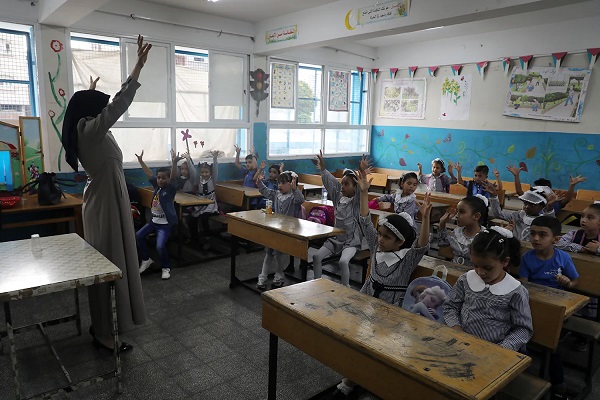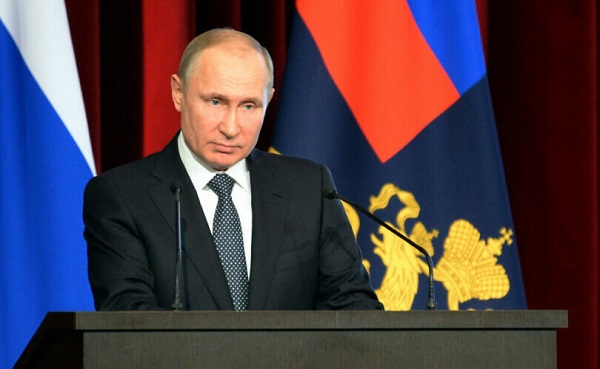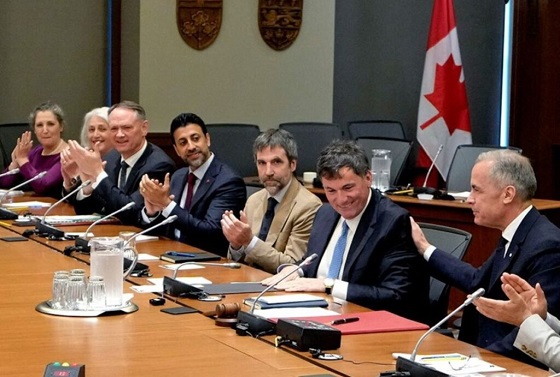Uncategorized
Funding government without border wall appears back on table

WASHINGTON — President Donald Trump appeared to back off his demand for $5 billion to build a border wall,
The White House set the tone Tuesday when press secretary Sarah Huckabee Sanders indicated that Trump doesn’t want to shut down the government, though just last week he said he’d be “proud” to do so. The president would consider other options and the administration was looking at ways to find the money elsewhere, Sanders said.
It was a turnaround after days of impasse. Without a resolution, more than 800,000 government workers could be furloughed or sent to work without pay beginning at midnight Friday, disrupting government operations days before Christmas.
One option that has been circulating on Capitol Hill would be to simply approve government funding at existing levels, without a boost for the border, as a stopgap measure to kick the issue into the new Congress next month. The chairman of the Appropriations Committee, Sen. Richard Shelby, R-Ala., confirmed late Tuesday his office was preparing legislation to keep government funded, likely into February. The White House preference was for a longer-term package, although the conversation remained fluid and Trump has been known to quickly change course, said a person familiar with the negotiations but not authorized to discuss them by name.
“We want to know what can pass,” Sanders said at a press briefing. “Once they make a decision and they put something on the table, we’ll make a determination on whether we’ll move forward.”
She also said the president “has asked every agency to look and see if they have money that can be used.”
The turn of events kick-started negotiations that had been almost nonexistent since last week’s televised meeting at the White House, when Trump neither accepted nor rejected the Democrats’ offer. They had proposed keeping funding at current levels of $1.3 billion for border security fencing and other improvements, but not for the wall.
The Senate’s top Republican and Democratic leaders began negotiating new proposals and talks were expected to continue.
Senate Majority Leader Mitch McConnell said he was confident there would not be a government shutdown. McConnell said a stopgap measure could be approved, though he suggested that House Minority Leader Nancy Pelosi, who is poised to become House speaker when the Democrats take control Jan. 3, would not want to saddle the new year with a budget brawl.
“If I were in her shoes, I would rather not be dealing with this year’s business next year,” McConnell said.
Pelosi and Senate Minority Leader Chuck Schumer have made it clear they are not interested in funding Trump’s border wall.
During a meeting earlier Tuesday on Capitol Hill, McConnell had proposed $1.6 billion for border fencing, as outlined in a bipartisan Senate bill, plus an additional $1 billion that Trump could use on the border, according to a senior Democratic aide unauthorized to speak about the private meeting.
Democratic leaders immediately spurned the proposal. Schumer called McConnell to reject it.
“We cannot accept the offer they made of a billion-dollar slush fund for the president to implement his very wrong immigration policies,” Pelosi told reporters. “So that won’t happen.”
Democrats also rejected the administration’s idea of shifting money from other accounts to pay for Trump’s wall. Schumer said there will be no wall money, “plain and simple.”
Pelosi will probably be able to quickly approve a longer-term measure to keep government running in the new year. She called it a “good sign” that the White House appeared to be backing off its demands.
The White House showed its willingness to budge as it became apparent the president does not have support in Congress for funding the wall at the $5 billion level. Sanders said Tuesday there are “other ways” to secure the funding.
“At the end of the day, we don’t want to shut down the government,” Sanders said on Fox News Channel. “We want to shut down the border from illegal immigration.”
Sanders pointed to the Senate’s bipartisan appropriation measure for the Department of Homeland Security, which provides $26 billion, including $1.6 billion for fencing and other barriers. It was approved by the committee in summer on a bipartisan vote.
“That’s something that we would be able to support,” she said, as long as it’s coupled with other funding.
But House Democrats largely reject the Senate’s bill because it includes 65 miles of additional fencing along the Rio Grande Valley in Texas.
Trump had campaigned on the promise that Mexico would pay for the wall. Mexico has refused.
It’s unclear how many House Republicans, with just a few weeks left in the majority before relinquishing power to House Democrats, will even show up midweek for possible votes. Many Republicans say it’s up to Trump and Democrats to cut a deal.
The standoff dispute could affect nine of 15 Cabinet-level departments and dozens of agencies, including the departments of Homeland Security, Transportation, Interior, Agriculture, State and Justice, as well as national parks and forests.
Shelby expected the stopgap measure, which would cover the seven appropriation bills for those departments, would pass. “Who would want to shut the government down?” he said.
Congress did pass legislation to fund much of the government through the fiscal year, until Oct. 1. But a partial shutdown would occur at midnight Friday on the remaining one-fourth of the government.
About half the workers would be forced to continue working without immediate pay. Others would be sent home. Congress often approves their pay retroactively, even if they were ordered to stay home.
Many agencies, including the Pentagon and the departments of Veterans Affairs and Health and Human Services, are already funded for the year and will continue to operate as usual. The U.S. Postal Service, busy delivering packages for the holiday season, wouldn’t be affected by any government shutdown because it’s an independent agency.
___
Associated Press writer Laurie Kellman in Washington contributed to this report.
Lisa Mascaro, Matthew Daly And Catherine Lucey, The Associated Press
Uncategorized
Cost of bureaucracy balloons 80 per cent in 10 years: Public Accounts

The cost of the bureaucracy increased by $6 billion last year, according to newly released numbers in Public Accounts disclosures. The Canadian Taxpayers Federation is calling on Prime Minister Mark Carney to immediately shrink the bureaucracy.
“The Public Accounts show the cost of the federal bureaucracy is out of control,” said Franco Terrazzano, CTF Federal Director. “Tinkering around the edges won’t cut it, Carney needs to take urgent action to shrink the bloated federal bureaucracy.”
The federal bureaucracy cost taxpayers $71.4 billion in 2024-25, according to the Public Accounts. The cost of the federal bureaucracy increased by $6 billion, or more than nine per cent, over the last year.
The federal bureaucracy cost taxpayers $39.6 billion in 2015-16, according to the Public Accounts. That means the cost of the federal bureaucracy increased 80 per cent over the last 10 years. The government added 99,000 extra bureaucrats between 2015-16 and 2024-25.
Half of Canadians say federal services have gotten worse since 2016, despite the massive increase in the federal bureaucracy, according to a Leger poll.
Not only has the size of the bureaucracy increased, the cost of consultants, contractors and outsourcing has increased as well. The government spent $23.1 billion on “professional and special services” last year, according to the Public Accounts. That’s an 11 per cent increase over the previous year. The government’s spending on professional and special services more than doubled since 2015-16.
“Taxpayers should not be paying way more for in-house government bureaucrats and way more for outside help,” Terrazzano said. “Mere promises to find minor savings in the federal bureaucracy won’t fix Canada’s finances.
“Taxpayers need Carney to take urgent action and significantly cut the number of bureaucrats now.”
Table: Cost of bureaucracy and professional and special services, Public Accounts
| Year | Bureaucracy | Professional and special services |
|
$71,369,677,000 |
$23,145,218,000 |
|
|
$65,326,643,000 |
$20,771,477,000 |
|
|
$56,467,851,000 |
$18,591,373,000 |
|
|
$60,676,243,000 |
$17,511,078,000 |
|
|
$52,984,272,000 |
$14,720,455,000 |
|
|
$46,349,166,000 |
$13,334,341,000 |
|
|
$46,131,628,000 |
$12,940,395,000 |
|
|
$45,262,821,000 |
$12,950,619,000 |
|
|
$38,909,594,000 |
$11,910,257,000 |
|
|
$39,616,656,000 |
$11,082,974,000 |
Uncategorized
Trump Admin Establishing Council To Make Buildings Beautiful Again


From the Daily Caller News Foundation
By Jason Hopkins
The Trump administration is creating a first-of-its-kind task force aimed at ushering in a new “Golden Age” of beautiful infrastructure across the U.S.
The Department of Transportation (DOT) will announce the establishment of the Beautifying Transportation Infrastructure Council (BTIC) on Thursday, the Daily Caller News Foundation exclusively learned. The BTIC seeks to advise Transportation Secretary Sean Duffy on design and policy ideas for key infrastructure projects, including highways, bridges and transit hubs.
“What happened to our country’s proud tradition of building great, big, beautiful things?” Duffy said in a statement shared with the DCNF. “It’s time the design for America’s latest infrastructure projects reflects our nation’s strength, pride, and promise.”
“We’re engaging the best and brightest minds in architectural design and engineering to make beautiful structures that move you and bring about a new Golden Age of Transportation,” Duffy continued.
Mini scoop – here is the DOT’s rollout of its Beautifying Transportation Infrastructure Council, which will be tasked with making our buildings beautiful again. pic.twitter.com/
9iV2xSxdJM — Jason Hopkins (@jasonhopkinsdc) October 23, 2025
The DOT is encouraging nominations of the country’s best architects, urban planners, artists and others to serve on the council, according to the department. While ensuring that efficiency and safety remain a top priority, the BTIC will provide guidance on projects that “enhance” public areas and develop aesthetic performance metrics.
The new council aligns with an executive order signed by President Donald Trump in August 2025 regarding infrastructure. The “Making Federal Architecture Beautiful Again” order calls for federal public buildings in the country to “respect regional architectural heritage” and aims to prevent federal construction projects from using modernist and brutalist architecture styles, instead returning to a classical style.
“The Founders, in line with great societies before them, attached great importance to Federal civic architecture,” Trump’s order stated. “They wanted America’s public buildings to inspire the American people and encourage civic virtue.”
“President George Washington and Secretary of State Thomas Jefferson consciously modeled the most important buildings in Washington, D.C., on the classical architecture of ancient Athens and Rome,” the order continued. “Because of their proven ability to meet these requirements, classical and traditional architecture are preferred modes of architectural design.”
The DOT invested millions in major infrastructure projects since Trump’s return to the White House. Duffy announced in August a $43 million transformation initiative of the New York Penn Station in New York City and in September unveiledmajor progress in the rehabilitation and modernization of Washington Union Station in Washington, D.C.
The BTIC will comprise up to 11 members who will serve two-year terms, with the chance to be reappointed, according to the DOT. The task force will meet biannually. The deadline for nominations will end Nov. 21.
-

 Business2 days ago
Business2 days agoWhy Does Canada “Lead” the World in Funding Racist Indoctrination?
-

 Media2 days ago
Media2 days agoThey know they are lying, we know they are lying and they know we know but the lies continue
-

 Focal Points2 days ago
Focal Points2 days agoThe West Needs Bogeymen (Especially Russia)
-

 Censorship Industrial Complex2 days ago
Censorship Industrial Complex2 days agoUS Condemns EU Censorship Pressure, Defends X
-

 Dan McTeague2 days ago
Dan McTeague2 days agoWill this deal actually build a pipeline in Canada?
-

 Bruce Dowbiggin19 hours ago
Bruce Dowbiggin19 hours agoWayne Gretzky’s Terrible, Awful Week.. And Soccer/ Football.
-

 Banks2 days ago
Banks2 days agoTo increase competition in Canadian banking, mandate and mindset of bank regulators must change
-

 Business2 days ago
Business2 days agoLoblaws Owes Canadians Up to $500 Million in “Secret” Bread Cash










